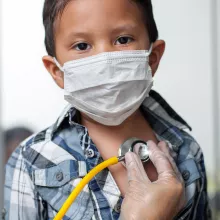Publications Menu
Summary: This fact sheet provides an overview of key state and national child health facts to inform work that is needed to make California the best state to raise healthy, thriving children. Authors present data that are unique to California children from Asian American (AA) subgroups that are separated from Native Hawaiian and Pacific Islander (NHPI) communities unless otherwise specified.
Estimates from the 2019, 2020, and 2021 California Health Interview Surveys (CHIS) and data from other sources are presented on these topics: population, mental health, protective factors, health coverage and access, school success and safety, oral health, community and family well-being, hate and discrimination, COVID-19, food access, economic well-being, and language access
Findings include:
- At least 1.5 million children and youth under 18 identify as Asian American (AA) including those who also identify with another race or ethnicity. They make up about 17% of the state’s nearly 9 million children.
- Nearly 1 in 3 (31%) AA youth in California report feeling depressed, and nearly 16% of AA youth in 7th, 9th, and 11th grade have considered suicide.
- More than 8 in 10 (86% or 907,435) AA children live in immigrant families with at least one parent or guardian who was born outside of the United States, and 91% of all AANHPI children are U.S. citizens.
- Nearly 1 out of 3 (30% or 241,038) AA children have insurance coverage that is inadequate to meet their needs compared to 20% of white children.
- Nearly 1 in 2 (46%) of AA 7th graders have experienced harassment and bullying in school — among the highest of any racial/ethnic group.
AA children and youth come from diverse and resilient cultural and linguistic backgrounds despite facing a legacy of systemic racism, xenophobia, and government-ordered forced relocation, displacement, false imprisonment, and detention. Systems and policymakers should identify and build on AA communities’ strengths, resources, and expertise. Community-defined protective factors — conditions or attributes that help mitigate or eliminate risks to health defined by community members themselves — are strengths that can help prevent and reduce health inequities impacting children from historically marginalized communities. These protector factors — such as maintaining AA cultural heritage and practices, bilingualism, and cultural identification — can guide the development of community-centered interventions that utilize and uplift unique community strengths to address persistent challenges.
Read the Publication:













